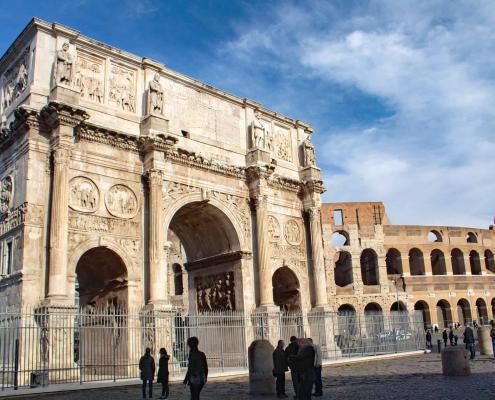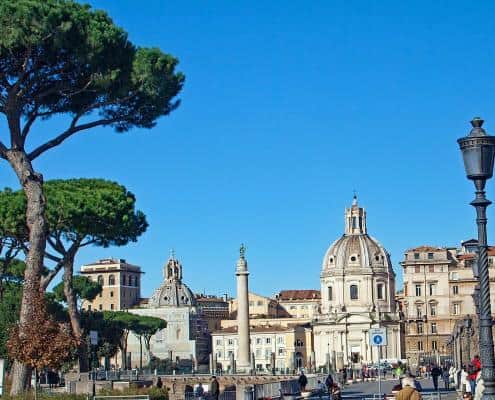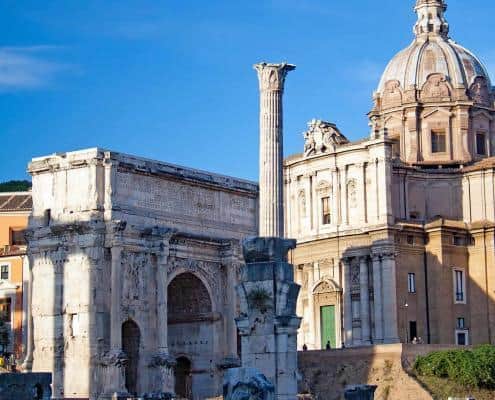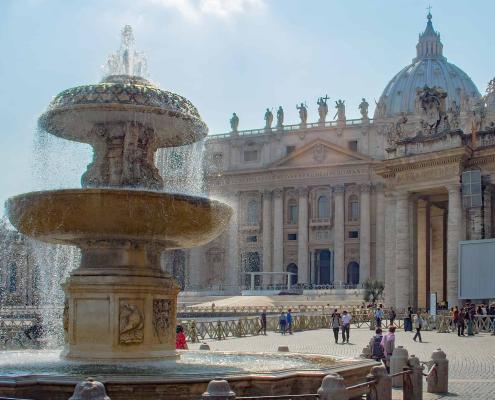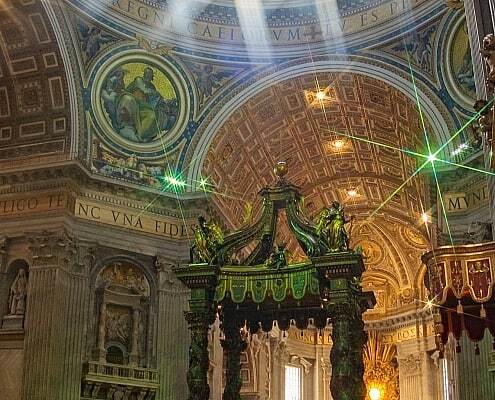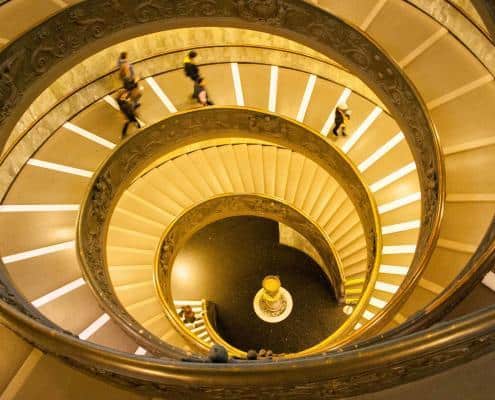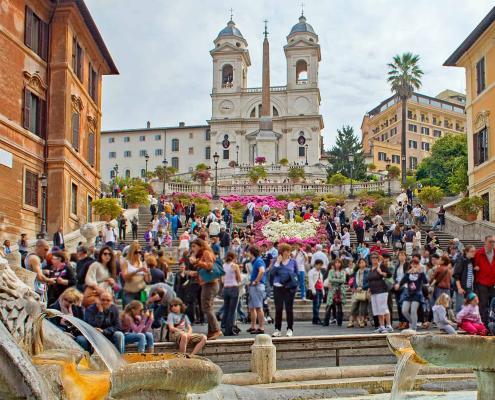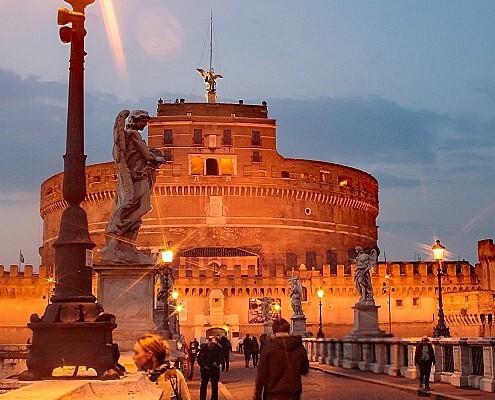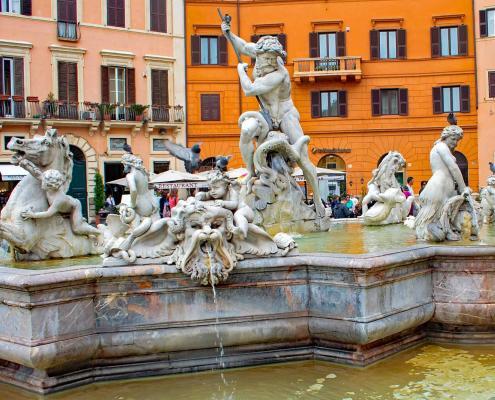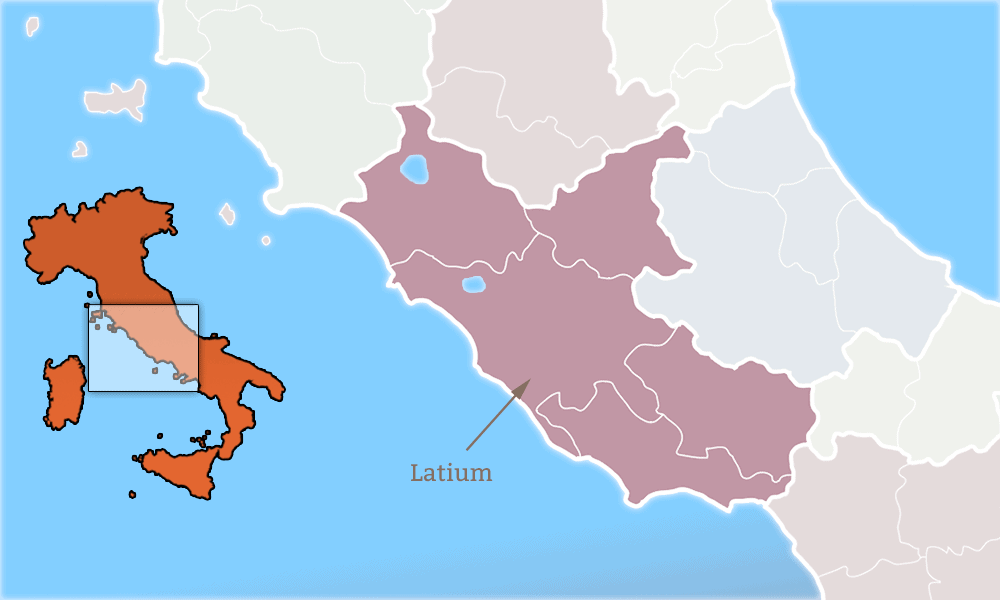Rome
Italian: Roma
There are so much sights to see in Rome that a short trip can only be a small introduction to the eternal city. If you want to get a little deeper into the best places to visit and cultural highlights, you should plan at least a week. And that’s not enough.
Historically, there are plenty of excavations and monuments from antiquity in Rome and the surrounding area. In addition, there are many masterpieces of art from the Renaissance period, which can be found both outdoors and in museums. You can spend a whole day in the Vatican Museums without getting bored.
Not to forget, there is the history of the popes in Rome. In addition to St. Peter’s Basilica, the Basilica di San Giovanni in Laterano and the Holy Staircase are important tourist attractions in Rome.
Immeasurable treasures from the Baroque and Renaissance period characterize the cityscape of Rome. The numerous churches from this period, as well as the Spanish Steps, elegant squares, and ornate fountains, invite you to linger and dream.
If you go only a little out of the city, you will find the oldest Roman road Via Appia Antica, the aqueducts and the ancient city of Ostia Antica. Also beautiful are excursions to Adrian’s Villa and Villa d ‘Este in Tivoli, as well as to the Roman Campagna, the Alban hills, and Castel Gandolfo.
Take plenty of time for the sights to see in Rome and enjoy the countless opportunities to get to know Rome in your own pace. Then take trips to Ostia Antica, Tivoli and the Castelli Romani.
Sights to See in Rome
We show you the places to visit in the eternal city of Rome. Rome has sights to see from antiquity and the Renaissance period. The heart of the Catholic Church beats in Rome with St. Peter’s Basilica and the Vatican. Find here the most beautiful tourist attractions in Rome.
Colosseum and Roman Forum
One of the most important sights to see in Rome is the Colosseum. At all corners and ends you will encounter the massive Building from antiquity of ancient Rome. After the legend of Romulus and Remus, Rome was founded on the Palatine Hill. So here was the beginning of the Roman Empire. The Palatine Hill lies above the Roman Forum, the center of power in the ancient city of Rome. In the Roman Forum, there were churches, temples, shops, civil life took place here.
Among the most famous ancient buildings, of course, are the Colosseum, where the gladiators had to leave their lives for pure entertainment. The Roman Forum on Capitol Hill was the center of power. The Imperial Forums and Obelisks were signs of the superiority of the Roman Empire.
Arch of Constantine
The three-sided Arch of Constantine Arco di Constantino, which honored Emperor Constantine, still stands on Via Triumphalis.
Capitol Square (Campidoglio) and Capitoline Museums
Capitol Square
The Capitol Square, called Campidoglio, with the Capitoline Museums are located on Capitol Hill, Monte Capitolino. This is the smallest of the seven hills on which Rome was founded. The hill with the Piazza del Campidoglio can be reached via a wide flight of stairs. At the top of the stairs sit the ancient statues of Castor and Pollux to the right and left. The equestrian statue of Marco Aurelio greets you in the middle of Capitol Square.
The Capitol Square is surrounded by three Renaissance-style palaces. In the two opposite palaces are the Capitoline Museums (Musei Capitolini). They are connected to one another by an underground passage.
Capitoline Museums
The Capitoline Museums were founded in 1471. It houses Roman bronze statues from the 1st century BC. The historical collection contains outstanding Roman sculptures. The most famous sculpture is the she-wolf suckling Romulus and Remus. She is the symbol of Rome. Other famous statues are the boy with the thorn in his foot (Spinario), the original of the rice statue by Marcus Aurelius, and many more.
You can also admire masterpieces by Titian, Caravaggio, Bellini, and many others in the Pinakothek.
St. Peter Cathedral & Dome
St. Peter’s Basilica
St. Peter’s Basilica is the largest Catholic church in the world. The papal altar is located above the tomb of St. Peter. The papal high altar is the most impressive bronze sculpture in Rome by the sculptor Gian Lorenzo Bernini. At 28 m high, when it was built in 1633, it was higher than any other structure in Rome.
The unique artistic features of St. Peter’s Basilica include, among others the marble group of the Pietà by Michelangelo, a statue of Emperor Constantine Gian Lorenzo Bernini, and the venerated bronze statue of St. Peters. In addition to St. Peter’s Basilica with the Pietà of Michelangelo and the high altar, the Dome is a magnet for visitors.
The Dome of St. Peter’s Basilica
The dome of St. Peter’s Basilica is the work of Michelangelo Buonarroti. The Pope had commissioned the 70-year-old architect Michelangelo to build the dome of St. Peter’s Basilica. From the dome of St. Peter’s Basilica, you have a wonderful view over St. Peter’s Square and all of Rome.
Vatican State
The Vatican State is the smallest state in the world and is located in the middle of Rome. It consists of St. Peter’s Basilica, St. Peter’s Square, the Vatican with the Vatican Museums and the Vatican Gardens. The Vatican is guarded by the Swiss Guards with their traditional uniforms. The Vatican also includes the Pope’s summer residence Castel Gandolfo in the Alban hills.
Vatikan Museums and Sistine Chapel
If you want to visit the Vatican Museums, you are entering the smallest state in the world, the Vatican. The Vatican is separated from Rome by city walls. The Vatican has its own currency, flag, stamps and license plates, and the Vatican radio station. The Vatican is guarded by the Swiss Guard in their traditional uniforms.
In the 18th century, the popes made their wealth of art treasures available to the public. The Vatican Museums came into being.
The Vatican Museums are a magnet for visitors. Great artistic treasures can be admired here:
- Michelangelo Buonarroti painted the Sistine Chapel with the Last Judgment and the creation of Adam. It is named after Pope Sixtus IV. The wall paintings show stories from the life of Moses and Christ.
- The Rooms of Raphael (Raffaello Sanzio) are painted with works such as the “School of Athens” and the Liberation of Saint Peter.
- There is also the Pinakothek with works by Leonardo, Caravaggio and Raffaello Sanzio
- The Egyptian and Etruscan museums with excavations from Egypt and monuments.
The Vatican Museums are a significant source of income for the Vatican.
The Vatican Gardens
The Vatican Gardens were laid out in 1279 as a place of mediation for the Pope. The Pope has his residence in a house in the middle of the Vatican Gardens.
The Pope’s guests brought plants and trees from all over the world as gifts. These found their place and line the beautiful walking paths and shady avenues.
A visit to the Vatican Gardens is only possible as part of a guided tour by prior arrangement.
Castel Sant’Angelo and Angel Bridge Ponte Sant’Angelo
Castel Sant’Angelo
The Castel Sant’Angelo was built in the Roman Empire under Emperor Hadrian. It served as a defensive castle for the popes and their refuge in the event of occupation and pillage. An 800 m long corridor was built between the Vatican and Castel Sant’Angelo. The “Passetto di Borgo” was a secret passage for the Pope’s escape route.
Today a museum is housed in Castel Sant’Angelo.
Angel Bridge Ponte Sant’Angelo
The Angel Bridge connects Castel Sant’Angelo with the center of Rome, the former Campo Marzio. The Angel Bridge Ponte Sant’Angelo was built under the Roman Emperor Hadrian. As Pons Aelius, it was one of the first and most important bridges over the Tiber. The ten angel statues were not placed on the bridge until the 16th century by the best sculptor, Gian Lorenzo Bernini.
Lateran Basilica
The Basilica of San Giovanni in Laterano is one of the less-visited sights in Rome. But the Lateran Basilica was once the seat of the popes. Today it is still the seat of the Bishop of Rome, who is also Pope. Here is also the Santa Scala, the 28 stairs where Jesus ascended to Pilate to receive his verdict for crucifixion.
Spanish Steps and Trevi Fountain
The Spanish Steps on the Spanish Square are among the most important sights to see in Rome.
Spanish Square
The names of the Roman squares sound magical like the Spanish Square with the Spanish Steps and the Barcaccia Fountain, a semi-inclined ship.
Around the Fontana della Barcaccia, the stone fountain by the sculptors Pietro and Gian Lorenzo Bernini, there is always lively activity, because the Spanish square is a popular meeting place for residents and tourists.
Spanish Steps
The correct name of the Spanish Steps is Scalinata di Trinità dei Monti, because the magnificent late Baroque staircase connects the Spanish Square with the Trinità dei Monti church on the Pincian Hill (pincio).
It is most beautiful in spring when the Spanish Steps are adorned with flowers.
Trintià dei Monti Church
The Trinità dei Monti church sits enthroned on the Pincian hill. With its two towers and the obelisk in front of it, it is very striking.
Trevi Fountain
The most famous ornate fountain is the Trevi Fountain. The sea god on a cart is pulled by two tritons. The Fontanta di Trevi is the largest fountain in Rome and one of the most famous fountains in the world. According to legend, you have to throw a coin over your shoulder into the Trevi Fountain with your left hand, then you come back to Rome.
Get to know the most beautiful places and fountains on a guided walk with a competent guide and get a lot of insider tips.
Pantheon
The Pantheon was a great temple in ancient Rome. It was built by Emperor Hadrian to honor the gods of Olympus.
The enormous dome of the Pantheon was the largest dome in the world and was the model for the construction of the dome in St. Peter’s Cathedral. In the center of the dome, there is a large circular opening through which light falls into the interior of the Pantheon.
Piazza Navona and Campo de’ Fiori
The beautiful Roman squares of Piazza Navona and Campo de ‘Fiori are must-see sights in Rome.
Piazza Navona
In ancient times, where the Piazza Navona is located today, was the stadium of the Roman Emperor Domitian. The shape of the Roman stadium has been preserved. Where the auditorium used to be in ancient times, houses now line the Piazza Navona.
Piazza Navona has three fountains. There’s the big four-stream fountain, Fontana dei Quattro Fiumi, with the obelisk in the middle of the square. At the end of Piazza Navona are the Neptune Fountain and the Fontana del Moro.
Campo de’ Fiori
Campo de ‘Fiori is one of the most beautiful squares in Rome. In Piazza di Campo de’ Fiori, witches and criminals were once publicly executed. The monument of Giordano Bruno in the middle of Campo dei Fiori reminds of this. The Dominican monk was a victim of the Inquisition. Today, Piazza Campo de’ Fiori hosts the weekly markets.
Get to know the most beautiful places and fountains on a guided walk with a competent guide and get a lot of insider tips.
Piazza del Popolo
Piazza del Popolo is one of the largest and most beautiful squares in Rome. It is right under Pincian hill. In the middle of the Piazza del Popolo is the Egyptian obelisk Flaminio. In the church of Santa Maria del Popolo you can admire masterpieces by famous Renaissance artists. The painter Caravaggio painted the paintings Conversione di San Paolo (Conversion of Paul) and Crocifissione di San Pietro (Crucifixion of Peter) here.
Villa Borghese and Galleria Borghese
A special highlight is a visit to the large park of Villa Borghese with the statues and the extraordinarily beautiful art collection of the Galleria Borghese with paintings and marble statues by the best artists of the Renaissance.
Villa Borghese is the green lung in Rome and a popular park for hiking and sports. On the park area there is the summer villa, the Galleria Borghese and the gardens of the Villa Borghese with pavilions, ponds, riding facilities.
Galleria Borghese Art Collection
Cardinal Scipione Caffarelli-Borghese acquired the property of the Villa Borghese in 1605. In the palace, he housed his private art collection, consisting of marble statues and paintings from the Renaissance.
The Borghese Gallery is one of the most valuable and famous private art collections and an important sight to see in Rome.
If you want to visit the Borghese Gallery, you need reserved tickets. We would be happy to offer you this along with an exclusive tour to admire works of art from the Baroque and Renaissance periods.
The painting collection houses masterpieces by (Tiziano Vecellio, (Raffaelo Sanzio, Caravaggio (Michelangelo Merisi), Lorenzo Lotto, Peter Paul Rubens and many others).
You can admire some of the most beautiful marble sculptures by Gian Lorenzo Bernini and Antonio Canova, as well as ancient marble statues.
Villa Borghese Gardens
The Villa Borghese Gardens are located on Pincian Hill above Piazza del Popolo, near the Spanish Steps.
Access to the gardens of Villa Borghese is free.
Piazza Venezia - Altar of the Fatherland
Piazza Venezia
Piazza Venezia is the central square in Rome and a transport hub. That was it already in ancient Rome, because this is where the Via Flaminia (Via del Corso) ran, which was built in the year 200 before Christ.
National Monument Victor Emmanuel II
The Victor Emmanuel II monument, known as the Altar of the Fatherland (Altare della Patria), dominates Piazza Venezia.
The monument is dedicated to Victor Emmanuel II, whose equestrian sculpture is in front of the monument. He came from the House of Savoy and was the first king of Italy.
In the portico, there are figures representing the regions of Italy. The palace is open to the public and you have a beautiful view over Rome.
Trastevere
District Trastevere
In ancient times, Trastevere was outside the Roman city walls, because it was “on the other side of the Tiber”. Workers, immigrants and Jews lived in Trastevere. Even in the Middle Ages, Trastevere with its labyrinth of narrow streets remained a working-class district. Today Trastevere is a picturesque, lively district with many bars and restaurants where you can still eat typical Roman dishes.
Basilica of Santa Maria di Trastevere
In the center of Trastevere is one of the oldest churches in Rome from early Christian times, the Basilica Santa Maria di Trastevere in the Piazza Santa Maria di Trastevere of the same name.
Porta Portese
The Porta Portese flea market takes place on Sunday mornings on the southern bridge of Trastevere Porta Portese. This is a popular attraction for locals and foreigners.
Villa Farnesina
Villa Farnesina is one of the most beautiful sights to see in Rome for art lovers and maybe even an insider tip. The villa with Raphael’s Loggia of Cupid and Psyche is a masterpiece of the Renaissance. It is located on the Tiber in the Trastevere district of Rome.
Raphael’s Loggia of Cupid and Psyche
The loggia got its name from the decoration. The frescoes represent episodes from the fable of the psyche. The cycle of the story of Cupid and Psyche was decorated by Rafaello Sanzio (Raphael) and his students. The Loggia of Cupid and Psyche served its owner Agostini Chigi as a stage for parties and theater performances.
The Jewish Ghetto of Rome
Already in pre-Christian times there was a Jewish community in Rome, one of the oldest Jewish communities in the world. It was located between the Tiber Island, Largo Argentino and Piazza Venezia and was one of the largest in Europe at the beginning of the 19th century. The Jewish quarter has retained its characteristics and traditions. You can eat kosher here and there are shops with typical products. The synagogue and the turtle fountain in Piazza Mattei are particularly beautiful. The history of the Jews in Rome can be studied in the Jewish Museum Museo Ebraico di Roma.
Circus Maximus - Antique Racing Track
The Circus Maximus was the first and largest stadium in ancient Rome and an antique racing track. In the Circus Maximus, popular chariot races took place.
The Rape of the Sabine Women
Do you know the great paintings and sculptures that tell of the Rape of the Sabine women? According to a legend, the Circus Maximus was the setting for it.
The Roman governor Romulus had invited the Sabines with their wives and daughters to the games in the Circus Maximus. They all came from the Colline Romane, the mountains around Rome. Upon a sign, guys kidnapped the maidens present and brought them to the Roman patricians, who they married. The betrayed families were appalled, but powerless against the Roman state.
Baths of Caracalla
The Roman Emperor Caracalla had the gigantic thermal baths built on the Aventine Hill. The structure of the Caracalla thermal baths corresponded to the typical Roman thermal baths, consisting of a changing room (apodyterium), the large natatio (swimming pool) and palestra (sports field). The laconica (sauna) and the caldarium (warm bath) followed as the centerpiece.
The water was brought in via a newly built aqueduct Aqua Marcia Antoniniana Forma Iova and temporarily stored in cisterns (castellum aquae). The water got into the bathing facilities through lead pipes.
About 2000 Romans visited the Caracalla Baths per day.
Today you can admire the ruins of the Caracalla Baths during the opening times.
In summer, concerts and operas take place in the open air in a suggestive atmosphere.
On the occasion of the opening of the football world championship, the best Three Tenors in the world sang their unforgettable opera arias.
Via Appia Antica
Via Appia Antica – Important Trading Route in Ancient Rome
On the Via Appia Antica you can walk in the footsteps of antiquity. It was built in the 4th century BC, making it one of the oldest roads in the world. The original pavement is still preserved on some road sections and you can walk in the footsteps of antiquity and Roman emperors. It was one of the most important trade routes of the Roman Empire and connected Rome with the port city of Brindisi.
The Via Appia Antica began at the Circus Maximus, led past the thermal baths of Caracalla to the Aurelian city wall. There the Via Appia Antica left the city of Rome.
At the fork in Via Appia Antica is the church of Santa Maria in Palmis. She is better known as Domine Quo Vadis?
Domine Quo Vadis Church
The Domine Quo Vadis church is located at the place where, according to legend, Peter, fleeing from Rome, met Jesus. Peter asked Jesus: Domine, quo vadis? (Lord, where are you going?) And Jesus answered him Eo Romam iterum crucifigi (I am going to Rome to be crucified again). After these words Peter returned to Rome and was also crucified.
Catacombs of Rome
Along the Via Appia Antica there are two important cemeteries of ancient Rome: the Callixtus Catacombs (San Callisto) and the Sebastian Catacombs (San Sebastiano).
Caecilia Metella Tomb
The archaeological excavations of the Caecilia Metella and Castrum Caetani mausoleum are located around the 3rd milestone of the Via Appia Antica.
Park of the Aqueducts
Continuing in the footsteps of antiquity, the paths on the Via Appia Antica lead to the Roman Campagna and Castel Gandolfo. The park of the aqueducts is definitely worth a visit.
Visit the Via Appia Antica
You need to plan at least a full day to visit the sights in Via Appia Antica. Since the distances are long, we are happy to provide you with a specialized guide and a vehicle.
Catacombs of Rome
Catacombs
Catacombs are the underground cemeteries that were created by Christians and Jews. Since the Christians refused to cremate the dead in order to raise the corpse one day, and each grave could only be used once, there were space problems in the cemeteries that always had to be outside the city walls. The catacombs were used as underground tombs. The most famous Christian catacombs in Rome are the Callixtus catacombs (San Callisto) and the Sebastians catacombs (San Sebastiano).
San Sebastiano Pilgrimage Church
Next to the entrance to the catacombs is the Basilica of St. Sebastian Fuori Mura. It was built in the 4th century near the catacombs. Legend has it that the relics of Saints Peter and Paul were hidden there to keep them from destruction.
Ara Pacis Augustae
The “Altar of Peace of Augustus”
The altar is supposed to represent the peace “Pax Augusta”, the goddess of peace. The monument was created in 13 BC and dedicated to the Roman Emperor Augustus after his victories over Spain and Gaul. The large stone monument Ara Pacis Augustae is located in a glass exhibition hall near the Tiber.
What to do in Rome in 3 Days
What can you see and do in Rome in 3 days or in one week? We have developed itineraries that allow you to visit many of the tourist attractions and experience different eras of Roman history.
Rome in 3 Days
You can admire the main attractions in Rome in three days, beginning from ancient Rome to Christian Rome and to the most beautiful squares and the famous fountains of Rome. An ideal itinerary for first-time visitors to Rome with private guided tours.
- You will visit the Vatican Museums and St. Peter’s Basilica. The highlight of the Vatican Museums is the Sistine Chapel, with the famous paintings of Michelangelo.
- Experience Roman history in the heart of ancient Rome, the Roman Forum, the Palatine and the Colosseum.
- Enjoy a stroll in the beautiful squares like Piazza Navona and Piazza di Spagna and admire the famous fountains.
Rome in One Week
We have put together tours for your visit to Rome, which you can carry out comfortably alone and on foot, or you can book a private tour to the important sights to see in Rome. Your private guide imparts historical knowledge in a pleasant and interesting way.
We have put together tours for your visit to Rome that you can comfortably do alone and on foot. Or you can book a private tour with us to the important sights to see in Rome. You will get skip-the-line tickets. Your tour guide will take you to the most beautiful Rome places to visit and convey historical knowledge in a pleasant and interesting way, peppered with a few funny anecdotes.
- The most beautiful squares and fountains in Rome
- Tour of Ancient Rome
- Trastevere, Tiber Bridge and Jewish Ghetto
- Via Appia Antica
- Ostia Antica
- In the footsteps of Caravaggio in Rome
- Trip to Tivoli
Here are our suggestions for some itineraries for Rome in one week with a daily program. If you can stay longer in the eternal city, you will find even more hidden corners of Rome with treasures from ancient times and the renaissance. Rome in one week itinerary
Day Trips from Rome
You should take a day trip from Rome to visit the former port city of Rome, Ostia Antica. Ostia Antica is easily accessible by metro from Pyramid Station. The ancient city is still amazingly well preserved and with a guided tour you can understand the everyday life of the old Romans very vividly.
You have to plan a visit to Tivoli in advance and take either a taxi or public buses. In a day trip from Rome you can see the ancient Hadrian’s Villa, a vast area with all the facilities of a Roman villa and pay a visit to the Villa d ‘Este with its beautiful water features in the gardens.
By train you get to Castelgandolfo, where the Pope has his summer residence. By bus you can reach the town Nemi at Lake Nemi. In this beautiful environment, you can walk in the footsteps of the romantics and enjoy the landscape that has been painted by the romantic painters.
Admission to the Colosseum with Skip-the-Line-Tickets
In order to enjoy the most important sights of antiquity, the Colosseum and the Roman Forum in peace, you should get the tickets beforehand. Otherwise, you have to expect long queues at the entrance of the Colosseum.
It’s best to get up early. The Colosseum opens at 8:30 in the morning and at this time there are only few visitors so you have peace and quiet for the tour. Tickets are time stamped and a maximum of 3000 people are allowed in at the same time, so there may be long queues at peak times from 10am. We are happy to provide you with the tickets together with a professional private tour.
Our tip: Buy the tickets with or without a guide in advance and don’t pay attention to the screaming providers of “Free Tour” or “Skip-the-Line.” The quality often leaves something to be desired and sometimes you lose a lot of time or have to come back again.
Security
You are not allowed to bring any luggage, metal objects or liquids into the Colosseum. There is no luggage storage. However, there is the possibility to refill bottles inside with drinking water.
Admission to the Vatican Museums with Skip-the-Line-Tickets
St. Peter’s Basilica and the Vatican are the symbols of the ecclesiastical state. They are known all over the world and now they are queuing up to visit St. Peter’s Basilica.
Every year, many thousands of people make pilgrimages to Rome to receive the papal blessing. The Vatican is a state in its own right and when you visit the Vatican Museums you enter this small state. The Vatican and St. Peter’s Basilica are closely guarded and can only be entered after personal and bag checks. Plan for your visit.
Our tip: Buy tickets with or without a guide in advance and do not pay attention to the screaming providers of “free tour” or “skip-the-line.”
We recommend a guided tour where you will learn about the main attractions. We will get you the tickets. These are personal and for a specific time.
Security checks at St. Peter’s Basilica and Vatican Museums
Please note that checks are carried out at the entrance with metal detector, i.e. no luggage, no knives, glass bottles, etc. may be brought into the Vatican (like at the airport).
Watch a Football Match of AS Roma and Lazio Rome
With two clubs AS Roma and Lazio, Rome has two world-class soccer teams. The games take place in the Olympic Stadium and football fans get tickets for the home games with overnight accommodation.
Enjoy an Opera at Teatro dell’opera Rome
How about an evening opera visit to Rome? The Teatro dell ‘Opera Rome is one of the younger opera houses, but it is built in the classical style of Italian opera houses and we recommend to round off the visit to the eternal city with an opera visit. In summer, with a bit of luck, there is an open-air performance in the ancient Caracalla Baths in a unique atmosphere. Ask us!
Painting Like the Artists of the Romantic
After the artists of antiquity and the Renaissance, a third wave of artists has discovered Rome and the Roman Campagna: The Romantics with their paintings of landscapes and lakes. How about a trip through Italy with a painting course under professional guidance? This trip can be organized for groups and companies according to individual wishes.
Transport in Rome
Most tourists come to Rome by plane. There are the two airports Fiumicino and Ciampino. Both airports have regular shuttle buses to the central railway station in Rome.
Also recommended is the high-speed train, which takes you from Milan to Rome in 3 hours. Termini, Tiburtina and Fiumicino stations are connected to the highspeed railway, Treni di alta velocità.
We advise against exploring Rome by car. Getting there is often associated with traffic jams and traffic within the city stressful. In Rome, there is the Metro-Bus-Ticket, which you can use to move around for 48 hours using public transport. If you don’t live directly in the center and don’t want to explore everything on foot, we recommend this ticket, which you can buy in advance and validate when you arrive.
Hotel recommendation Rome
We combine your trip to Rome with exclusive hotels on favorable terms. This is not always easy, but we are usually able to do so.
- Palm Suites (5 stars)
- Lifestyle Suite Rome (5 stars)
- Margutta 19 (Small Luxury Hotels of the World) (5 stars)
- Hotel Hassler Rome (5 stars)
- Hotel Mancino 12 (4 stars)
- Hotel Martis Palace (4 stars)
Please include your desired hotel at the time of the inquiry, if this is important to you. Otherwise, the desired hotel category is enough for us.
Rome Sights to See and Itineraries in Rome for Private Tours – Our Proposals
Please find our proposals for guided tours and itineraries in Rome for individual travelers and groups. Do not hesitate to contact us for your tailor-made travel to Rome and Italy.
Private Travel Group Travel




